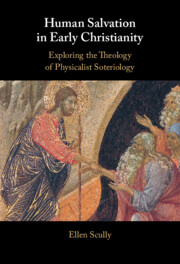Book contents
- Human Salvation in Early Christianity
- Reviews
- Human Salvation in Early Christianity
- Copyright page
- Contents
- Acknowledgments
- 1 The Rise and Fall of Early Christian Physicalist Soteriology
- 2 Scholarly Approaches to Physicalist Soteriology
- 3 Athanasius
- 4 Hilary of Poitiers
- 5 Marius Victorinus
- 6 Gregory of Nyssa
- 7 Cyril of Alexandria
- 8 Maximus the Confessor
- 9 The Almost, but Not Quite, Physicalists
- 10 Constructive Approaches to the Historical Reality of Physicalism
- Bibliography
- Index
5 - Marius Victorinus
“Harnackian-Style” Platonic Physicalism
Published online by Cambridge University Press: 09 January 2025
- Human Salvation in Early Christianity
- Reviews
- Human Salvation in Early Christianity
- Copyright page
- Contents
- Acknowledgments
- 1 The Rise and Fall of Early Christian Physicalist Soteriology
- 2 Scholarly Approaches to Physicalist Soteriology
- 3 Athanasius
- 4 Hilary of Poitiers
- 5 Marius Victorinus
- 6 Gregory of Nyssa
- 7 Cyril of Alexandria
- 8 Maximus the Confessor
- 9 The Almost, but Not Quite, Physicalists
- 10 Constructive Approaches to the Historical Reality of Physicalism
- Bibliography
- Index
Summary
While Marius Victorinus was not on the lists of physicalists given by the German liberal Protestants of the nineteenth century, his physicalism is the closest match to Harnack’s definition of physicalism: Victorinus provides a “textbook example” of physicalist soteriology. Victorinus is the only physicalist who teaches that Christ assumes and transforms a platonic-type form of humanity, which then, through its paradigmatic power, transforms all individuals patterned on that form. Victorinus’ physicalism is both a participation in and development of Neoplatonic chain of being logic. Scholarly emphasis on Victorinus’ famous insistence on salvation by faith has obscured the physicalist foundation of Victorinus’ soteriology.
- Type
- Chapter
- Information
- Human Salvation in Early ChristianityExploring the Theology of Physicalist Soteriology, pp. 130 - 160Publisher: Cambridge University PressPrint publication year: 2025

